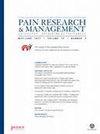Can Ultrasound-Guided Continuous Paravertebral Block Reduce the Incidence of Chronic Postsurgical Pain in Patients with Thoracoscopic Lung Cancer Surgery? A Randomized Controlled Trial
IF 3
3区 医学
Q2 CLINICAL NEUROLOGY
引用次数: 0
Abstract
Background. Thoracoscopic lung cancer surgery is accompanied by severe pain. Both continuous paravertebral block (CPVB) and continuous wound infiltration (CWI) are widely used for perioperative analgesia in thoracoscopic surgery. However, the effects of these different methods on chronic postsurgical pain (CPSP) are still unknown. Patients and Methods. This prospective randomized controlled trial assessed the eligibility of 113 patients. Ninety-seven patients who met the inclusion criteria were randomly divided into a CPVB group and a CWI group, and 80 patients were analyzed in the final study. The primary outcome measures were the incidence and intensity of chronic postsurgical pain (CPSP) at 3, 6, and 9 months after surgery. The secondary outcome measures were the numerical rating scale (NRS) score of rest and activity at 12, 18, and 24 hours and on the 2nd, 3rd, and 7th days postoperatively; the Barthel Activities of Daily Living (ADL) score of activity levels on the 1st, 2nd, 3rd, and 7th days postoperatively; and the long-term quality of the life score at 3, 6, and 9 months postoperatively. Results. The incidence of chronic postsurgical pain in the CWI group was significantly higher than that in the CPVB group at 3, 6, and 9 months after surgery (all ). The intensity of chronic postsurgical pain was significantly decreased in the CPVB group at 3, 6, and 9 months after surgery ( . NRS-R and NRS-A scores were significantly decreased in the CPVB group within the first week after thoracoscopic surgery ( ). ADL scores were increased in the CPVB group within 3 days postoperatively. However, there were no differences in the ADL score on the 7th postoperative day or the long-term quality of the life score at 3, 6, and 9 months postoperatively. Conclusion. Continuous ultrasound-guided paravertebral block reduced the intensity of acute pain within 7 days postoperatively and reduced the incidence of chronic pain at 3, 6, and 9 months after surgery, but there was no significant advantage in long-term quality of life. This trial is registered with ChiCTR2000038505.超声引导下连续椎旁阻滞能降低胸腔镜肺癌术后慢性疼痛的发生率吗?随机对照试验
背景。胸腔镜下肺癌手术伴随着剧烈的疼痛。连续椎旁阻滞(CPVB)和连续伤口浸润(CWI)是胸腔镜手术围手术期广泛应用的镇痛方法。然而,这些不同的方法对慢性术后疼痛(CPSP)的影响仍然未知。患者和方法。这项前瞻性随机对照试验评估了113例患者的资格。97例符合纳入标准的患者随机分为CPVB组和CWI组,最终分析80例患者。主要结局指标是术后3、6和9个月慢性术后疼痛(CPSP)的发生率和强度。次要观察指标为术后12、18、24小时及第2、3、7天的休息和活动数值评定量表(NRS)评分;术后第1、2、3、7天活动水平Barthel日常生活活动(ADL)评分;以及术后3、6、9个月的长期生活质量评分。结果。术后3、6、9个月,CWI组的术后慢性疼痛发生率明显高于CPVB组(P <0.05)。CPVB组术后3、6、9个月慢性疼痛强度明显降低(P <0.05。CPVB组胸腔镜术后1周内NRS-R和NRS-A评分显著降低(P <0.001)。CPVB组ADL评分在术后3 d内升高。然而,术后第7天的ADL评分和术后3、6、9个月的长期生活质量评分没有差异。结论。连续超声引导下椎旁阻滞可降低术后7天内急性疼痛强度,降低术后3、6、9个月慢性疼痛发生率,但在长期生活质量方面无明显优势。该试验注册号为ChiCTR2000038505。
本文章由计算机程序翻译,如有差异,请以英文原文为准。
求助全文
约1分钟内获得全文
求助全文
来源期刊

Pain Research & Management
CLINICAL NEUROLOGY-
CiteScore
5.30
自引率
0.00%
发文量
109
审稿时长
>12 weeks
期刊介绍:
Pain Research and Management is a peer-reviewed, Open Access journal that publishes original research articles, review articles, and clinical studies in all areas of pain management.
The most recent Impact Factor for Pain Research and Management is 1.685 according to the 2015 Journal Citation Reports released by Thomson Reuters in 2016.
 求助内容:
求助内容: 应助结果提醒方式:
应助结果提醒方式:


